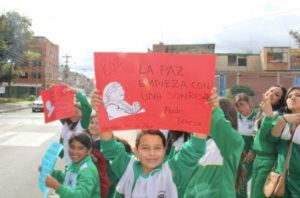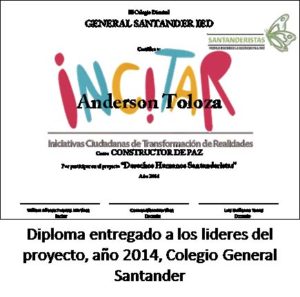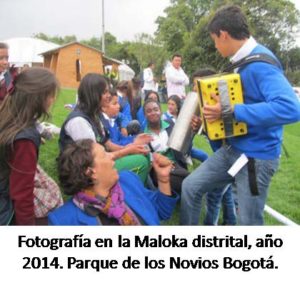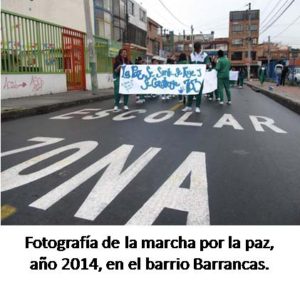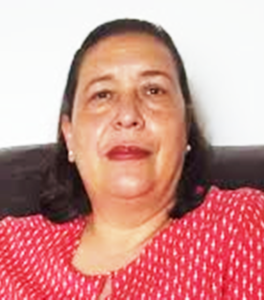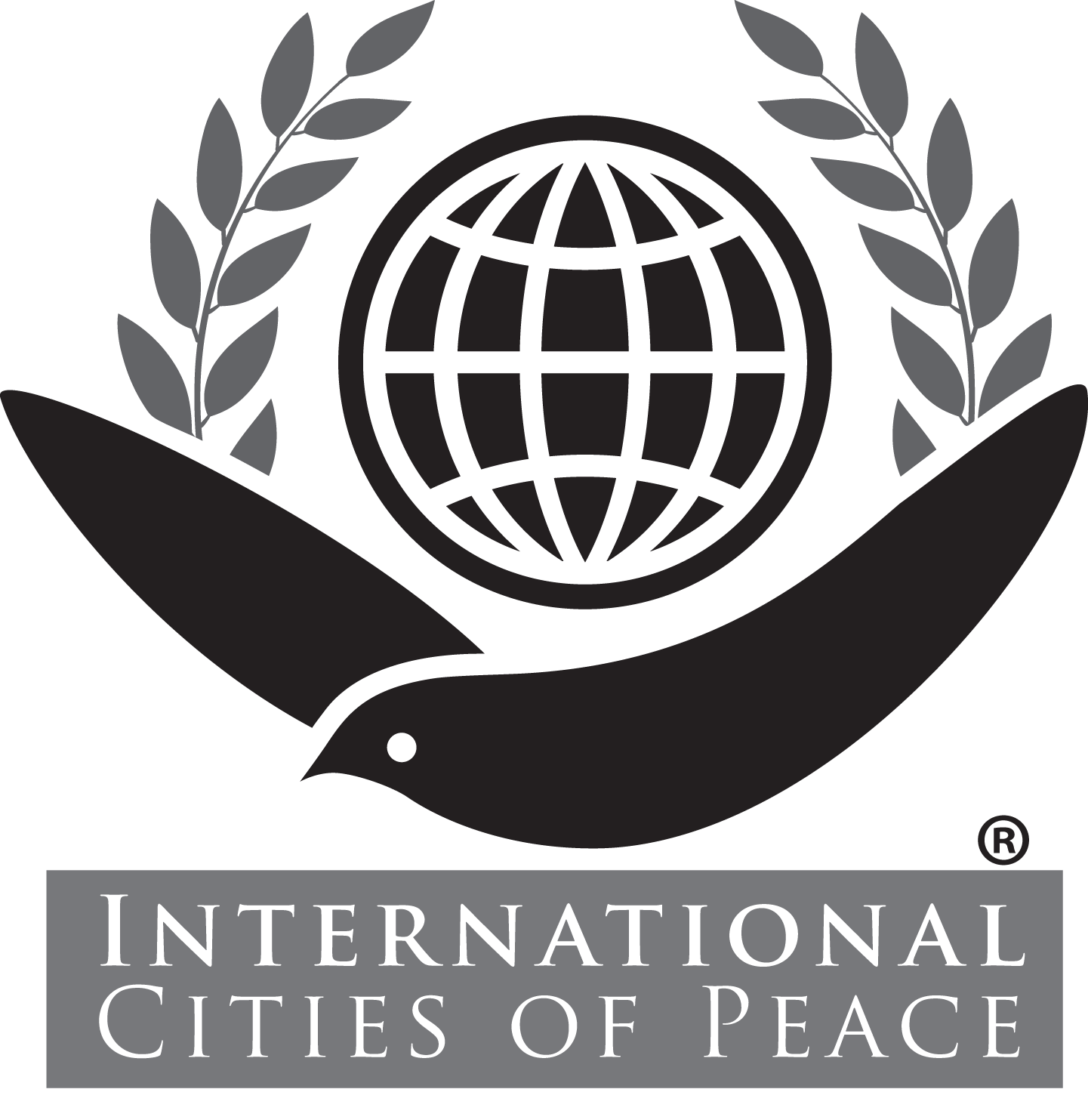Bogotá, Colombia: City of Peace
Welcome to Carmen Elena Martinez, Professor Luis Guillermo Torres Perez, and the citizens of Bogotá, Colombia who have been working in their community to create a culture of peace. The Santanderists organization is firmly committed to human rights and nonviolence.
Note: Introduction page with information primarily at the time of joining International Cities of Peace. For updates, please contact the liaison.
HUMAN RIGHTS.
Santanderists FREEDOM, JUSTICE AND PEACE.
SCHOOL GENERAL SANTANDER IED – BOGOTA COLOMBIA USAQUEN SYSTEMATIZING an educational experience and LIFE
Authors: CARMEN ELENA MARTINEZ mendoza and GUILLERMO LUIS PEREZ TORRES
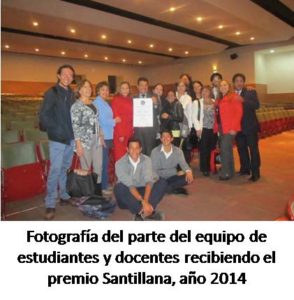
Speak on Human Rights in a context in which every day becomes more urgent to find scenarios for exercise, goes from being a necessity, a condition and life expectancy. That is why the General Santander School IED, located in the town of Usaquén Bogot, for ten years, we have been fortunate to have a number of educational projects, which have not only contributed to the educational quality of the institution but they have created bonds of unity, reconciliation, enjoyment, interaction and human development.
Since 2005, the project has given us the opportunity to create a space where children know their rights, the exercise and promote a culture of nonviolence, reconciliation and tolerance began. Part of this history, actions, transformations and the empowerment they feel young as true “Builders of Peace” during the last ten years, is what narrate below, which has been reflecting.
INTENTION OF THE INITIATIVE
● Raise awareness through workshops, videos, forums, meetings, conferences, outings and daily contact to the educational community on the principles of nonviolence, to form student leaders at every grade of school (day later), for the organization and strengthening Nonviolence movement in the educational community.
● Integrate and master the process to intensify throughout the Community achievements include: students, teachers / as. parents and guardians.
● Developing leaders nurseries that provide feedback from the course of Nonviolence in Santanderistas Community and beyond.
● Socialize other educational and neighborhood communities the ideal of nonviolence as an alternative way in the Colombian reality.
● Find support and guidance of movements with more experience in the practice of nonviolence locally, nationally and internationally.
LEARNING DURING THE YEARS
Learning during the decade between 2005 and 2006, we have consolidated in the General Santander School pedagogical proposal, involving the community around Santanderist practice of Human Rights and Nonviolence.
We are committed to build a true community of peace. Commitment that until today, been the foundation of the project: to form every day as a nonviolent community fanning flame of spirituality. In this path to nonviolence we have used the city as a space for reflection and have taken action and playful dialogue for coexistence. We have also led to situations involving the analysis and solution of problems of coexistence through the game for the collective transformation of weaknesses and strengths empowerment.
One of the main difficulties we had in the beginning, and that persists today, is managing impulsivity students. This type of action creates difficulties in resolving conflicts, lack of planning and the difficulty to anticipate consequences; generating lack of confidence in them, a tough attitude to enjoyment with low skills and little social commitment and sense of belonging, triggering violent situations.
What we think and learned about the symbol of our project. The project symbol, the butterfly, is one of the most important lessons over the years such as: processing capacity, coexistence amid difference, the strength of fragility, persistence and multiple perspectives: about peace and actions to achieve it.
DURING THE WAY: CHANGES AND CONTINUITIES.
During the first four years, we developed different activities to create a culture of coexistence within the institution. However, in 2009, before the imminent closure of the institution, parents, students and several teachers joined efforts to preserve the institutions of school and out in another country, for this reason, the District Department of Education, took on lease a venue for her school work. The transfer of the headquarters, brought situations that became a cause for reflection on the part of the educational community: territoriality, changing almost all the teaching staff and most of the student population, leading to propose new activities from the Project.
By 2010, the project, under the guidance of Professors Carmen Elena Martinez of Natural Sciences and Juan Carlos Alvarez of Social Sciences, picked up the feelings of the students, who became the main input for the development of educational proposals and gave the current name of the initiative: “Human Rights and: Santanderistas for freedom, justice and peace”.
In 2011, upon termination of the lease of the office awarded in 2009, a new change of venue is made and with this, the teacher Luis Guillermo Torres goes to support the initiative. At that time, both the project and the institution congregate to maintain cohesion and to establish strategies for the new community (students and neighbors) saw the school as a “land of peace” slogan that has accompanied until today activities of the project.
In 2012, the project is strengthened by students who are empowered with the support of the Javeriana University and the Institute Foundation for Peace building FICONPAZ, a second version of the peace march and the first human rights forum is done locally.
In 2013, the process of support to the National Network of Initiatives for Peace and against REDEPAZ War, allowed the formation of the project leaders students this year, the activities were aimed at the institutional relevance and search agency support.
During 2014 the project was joined by INCITE: Citizen Initiatives Transformation Realities public policy of the District Department of Education. With this support, it has strengthened the training of students through workshops held during the first half of 2014. During the second half of the year, let accompaniment, first set a budget input to strengthen the 2015 project, but also to strengthen support networks with other initiatives in Bogota, with the participation of the Maloka District.
PRACTICES THAT ALLOW TRANSFORMATION OF REALITIES: SANTANDERISTAS FREEDOM, JUSTICE AND PEACE AND ENCOURAGEMENT.
In looking for peace scenarios, students, teachers and parents, we have reflected on strategies to enable the General Santander School to be a land of peace. Such reflections are possible thanks to: first joint effort between students and teachers, second for the unconditional support of much of the equipment of school principals and teachers, and third for the support of institutions and education policies sisters as the Institute for Pedagogical Research and Development IDEP and abetting, from which has been revitalized systematization of this experience, in order to contribute to a culture of peace, non-violence and transforming realities.
The practice of non-violence:
Find meeting places for students and teachers from the dialog experiences on the culture of peace has allowed students to empower its role as a social subject and transformation in the daily practices of the school, one of the most relevant we could demonstrate clearly, it is to find students and alumni of the college coherent attitudes and practice of human rights and peaceful coexistence exercise radiating in their contexts.While raising a culture of nonviolence, we need to unite reason and heart, to think, feel, speak and act in a coherent way. We must be able to see the multiple realities of peace, daily and day from family, work, school, relationships with peers, in the neighborhood, in every relationship of mutual support and tenderness. All this means that we must be also prepared to recognize how we make peace, day by day, and how we intelligently manage many everyday conflicts.
Nonviolence toward school practices.
Among other activities we can state: Educational Convivencias, Human Rights Training and reflection regarding the topic of alcohol consumption, diagnosing felt problematic by students, film forums, ongoing exercise participation, conferences to exchange experiences with other District educational institutions of the town, safe routes, healthy environments, revive the proposal of the pedagogy of the body (recognizing the body as key to the relationship with the other scenario) and creating spaces for training teachers in the rights issue humans. For this year our project received special recognition by the District Department of Education, under the 2010 fair forum.With the second change of venue, students take the initiative to organize the week for peace, within which a march is planned under the slogan: “General Santander School: land for peace.” This march is still carried out in the neighborhood, the community seeks to transcend the culture of peace circunvecina become bridge of interaction and solidarity with the neighborhood.
In 2012, besides the peace march, we organized the first local human rights forum, with the participation of several local and district educational institutions, with presentations on the exercise of human rights education. For this year, the IDEP, and systematization of institutional projects, we show how each of the projects.
They aimed at teaching human development, human rights being a transverse axis in this process. In this way we, along with other teachers of the institution, to pedagogical and curricular bases in the area of Human Development. In 2013 the art acquired an important place, with the excuse to carry out the week and the peace march and the second international forum on human rights.
Agency Support: New visions: With experience, we begin to open space in the community to work Santanderist key Paz with the collaboration and support of other agencies for training students and teachers: The Citizen Movement for No_ violence, Barcelona School of Peace, Peace Uniminuto School, Universidad Javeriana, the Cooperative COODEMA Magisterium and the District Department of Education with advice Prometheus, FICONPAZ, COLCIENCIAS and abetting, which has enabled us to reach this systematization project life.
Since 2014 INCITE accompanying gave a new reflection on the project, recognizing this educational commitment, as one of the Civic Initiative Transforming Realities, thanks to which it has strengthened the training of students through of workshops held until today. Thanks to Sergio Fuccz accompanying gesture has been achieved so far recognition of the contributions of this initiative from the different steps that trace policy.
By joining the INCITE strategy, let us recognize the work that students and teachers have made santanderistas towards a culture of peace and nonviolence within and outside the institution.
The first step, which sought to encourage ideas, opened a new perspective around our memories and encourage reflection on the road traveled during these ten years, at the same time provided an opportunity to find new areas of recognition, not only our initiative, but also the other educational district processes.
Second, to establish a think ourselves from the daily practice, we made it possible to reaffirm our pedagogical intentions, find several methodological gaps in local and district projection and evaluate the daily and institutional practices for empowering students and dedicated support team Teachers College of General Santander, no matter who do formal part of the team of teachers counselors, have shown that they are also cultivated a culture of nonviolence and solidarity in the processes become a transverse axis Project Institutional Education.
In 2015, from the Secretary of Education of Bogotá, through Inciting we were strengthened in training student group leaders in conflict resolution. We conducted the week for peace and fulfillment within their march for peace in the Altablanca neighborhood, where we are strengthening a culture of peace. With the assistance of the Center for Research and Popular / Education for Peace Program CINEP systematizing the experiment it was carried out and published in a book published in November 2015.
From experience we participated in two conversations of leaders. One conducted in Cinep, another author in Conversation at the launch of the book “Experiences of school communities that transform realities.”
What remains for us to go forward in 2016 we want to integrate a global community as it is International Cities of Peace, as members volunteers to allow us further development, to further knowledge of how to build peace in our territories and cities. Insist and persist, start again and again by the same dynamic of continuous change of the educational community and to remember that the collective construction is the synthesis of the effort of the whole community to maintain Santanderist proposal that enable peaceful coexistence in peace our homes, neighborhoods, towns, and Colombian cities.
Nonviolence, as the same peace as tools, raised in the first instance be able to perceive, to recognize its existence, to see its projection in interpersonal, social and political, of being and being sensitive to their living reality, as much or more as being able to see and notice the existence of violence in Colombia as a strange cognitive dissonance lives: it wants and longs for peace but the vast majority of reality is thought violence keys. Therefore culture of peace building is a continuous process that does not end because we are subject under construction.
ABOUT THE LEADERS
M. CARMEN ELENA MARTINEZ
Colombian M. Carmen Elena Martinez, Sucre, Colombia northern coast region Mojana Degree in Education with a major in chemistry and biology. Full-time teacher with the district Bogotá General Santander School in Usaquen.
My educational practice has been oriented to the teaching of natural sciences from the practice in 1993 was transferred to Benposta Boys Nation, whose mission is the design and development of projects, programs and actions that promote the recognition of children and youth as social subjects in a dynamic and effective restitution of their fundamental rights. Here I East since my specialty to work with young people affected by armed conflict and vulnerable.
In 1997, this community actively participate in the consolidation of office of Children for Peace and my continued work started by Colombia at peace, with many NGOs, universities, individuals who yearn for peace, primarily by active citizen of the Movement for Nonviolence “Here am Country”.
So to be transferred to the General Santander School in 2005, with the support of the entire educational community work every day in personal, group and community transformation, from human rights and nonviolence, to permeate the country we long: peaceful, protector and promoter of decent life, to allow diversity, word retrieval and dialogue as a means to overcome the overwhelming power of weapons .; with the exercise of citizen power as a basis for democracy; in the search for a relative truth that enables the encounter with the other and diversity, and the unquestionable renunciation of violence as a method.
We have started 2016 with the inclusion of our Santanderist to “International Cities of Peace, to document ourselves, inform, build relationships with leaders and organizations so we can continue to promote peace in the world community.
PROFESSOR LUIS GUILLERMO TORRES PEREZ
Luis Guillermo Torres Pérez: Bogota, Colombia, Bachelor of Social Sciences, a professor at the General Santander School District locality 1 (Usaquén); editor of textbooks in the area of social services for primary and secondary education in Colombia. Aspiring doctorate in education at the National Pedagogical University.
Since 2006, I’ve played my academic work in various fields of teaching and research communities in displacement, social organizations, adult education and reintegrated into civilian society.
Between 2006 and 2014, the teaching practice in the Cafam College and Continuing Education Program for youth and adults Cafam got pedagogical, educational and humane approach to the reality of the city and country tools. In this context I have developed several research involving the study of space, subjectivity and integration of social groups in processes of social transformation.
In 2010, upon becoming a teacher at the Department of Education of the District of Bogota, through the General Santander School, I had the opportunity to approach new scenarios from which, the practice of Human Rights has permeated my pedagogical processes learning from the “Human Rights: Santanaderistas for freedom, justice and peace” project together with Professor Carmen Martinez and Pedro Riano accompanying teacher and Ms. Fanny Sasa and especially learning given by students to this work. The project, being a collective action allows the participation of students and teachers to make our community a space in continuous search for peace. What has been achieved in myself and others, transformations, still unfinished to nonviolence and empowerment of Human Rights.
CONTACT INFO
For more information please contact:
Carmen Elena Martinez Mendoza <carelenmartinez@gmail.com>
ABOUT Bogotá, Colombia (from Wikipedia)
Bogotá, officially Bogotá, Distrito Capital, abbreviated Bogotá, D. C (during the time of Spanish rule and from 1991-2000 called Santafé de Bogotá) is the capital of Colombia and the department of Cundinamarca. It is administered as Capital District, and has autonomy in the management of its interests within the limits of the Constitution and the law. Bogotá is a territorial entity of the first order, with administrative powers that the law gives to the departments. It consists of 20 localities and is the political, economic, administrative, industrial, artistic, cultural, sports and tourist epicenter of the country.
It is located in the center of Colombia, in the natural region known as the Bogotá savanna, which is part of Altiplano Cundiboyacense formation located in the Eastern Cordillera of the Andes. It is the third highest capital in South America (after La Paz and Quito), at an average 2625 meters above sea level.
As the capital, home to senior agencies of the executive branch (President’s Office), legislative (Congress of Colombia) and judicial (Supreme Court, Constitutional Court, Council of State and the Superior Council of the Judiciary).
According to The Economist, in economic terms, Bogotá is known for its economic strength associated with the size of their production facilities to create companies and do business, financial maturity, attracting global companies and the quality of its human capital. It is the main market of Colombia and the Andean natural region, and the leading destination for new projects of foreign direct investment coming into Latin America and Colombia. It has the highest nominal GDP in the country, contributing most to the national total (24.7%), and it is the sixth largest city by size of GDP in Latin America (about USD 108,782 million), likewise, is the largest business platform of Colombia where most high-impact ventures occur.
El Dorado International Airport it has the largest volume of cargo transported in Latin America, and is second in number of people. It is the city of Colombia with the largest number of universities (114) and research centers, and has an important cultural offer, which is represented in many museums, theaters and libraries. The city is ranked 52 in the Global Cities Index 2014, and is considered a global city type “Beta” by GaWC.
DO YOU THINK YOUR COMMUNITY CAN BE A CITY OF PEACE? SEND AN EMAIL!
Note: If information or photos used here are copyrighted, please contact us and we will immediately delete the copyrighted material.
